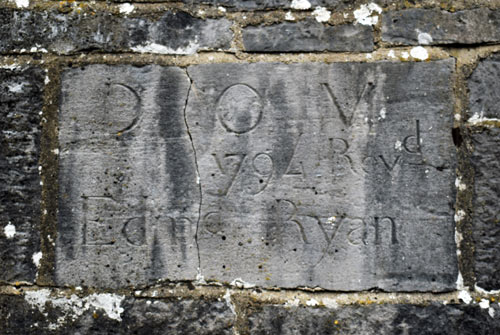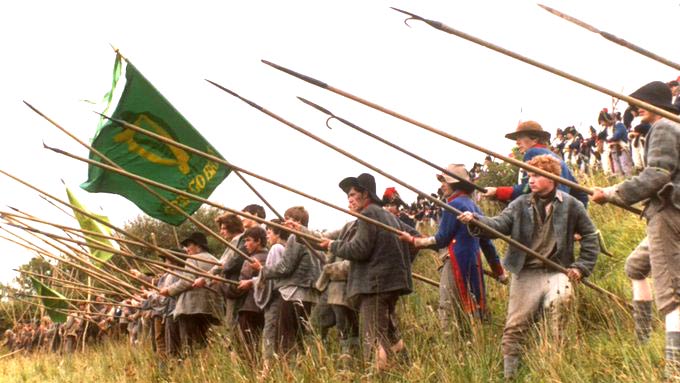Extract from the poem ‘The Irish Pike‘.
by poet John C. Colgan, first published in 1873.
A pike is the best of all weapons, the pride of my dear native land,
If I were a soldier to-morrow, I’d have a good pike in my hand;
When Cain had a row with his brother, and gave him the finishing stroke,
A pike was the weapon he used, for believe me, a pike is no joke.
Chorus: A fig for the bayonet and sabres, imported from Britain and France,
A fig for the thing called the rifle—our own Irish pike is the lance.
Special thanks to Rev. Fr. George Bourke AP, (Moycarkey, Littleton & Two-Mile-Borris), Thurles and Mr Gerry Bowe, Two-Mile-Borris, Thurles, for their assistance with research undertaken.
The Rev. Fr. Edmund Ryan, who succeeded Rev. Fr. John Cashin as parish priest of Moycarkey, Thurles, Co. Tipperary, was born in the year 1754 in the parish of Galboola, Littleton, Co. Tipperary.

The following incident is said to be connected with his death at the early age of just 48 years.
There lived at Lacken, Littleton, Co. Tipperary, (Laken Cross situated between Littleton and the Turnpike on secondary route R639), a blacksmith named Devlin who had become involved in the manufacture of pikes* for the Irish Rebellion of 1798 (Irish: Éirí Amach 1798); latter a major uprising against British rule in Ireland.

* Pikes: Long two-handed spears, (see above) wielded by foot soldiers. Each pike was fitted with a heavy wooden shaft 3 to 7.5 metres long (10 to 25 feet) and weighing approximately 2.5–6 kg (5.5–13.2 lb), and tipped by various types of leaf-shaped steel spearheads.
The then English authorities, who had been informed of Devlin’s activities, sent troops from Kilkenny city to arrest Devlin.
Devlin taken unawares and terrified by the fact that the soldiers had discovered his concealed pikes, said that they had been made to order, for Fr. Edmund Ryan.
On acquiring this false information, the soldiers proceeded to Fr. Ryan’s residence at Turtulla, Thurles, but in passing through the townland of Archerstown, Thurles, one of the soldiers confided in a man of his acquaintance along the way, details of the true object of their journey into Co. Tipperary.
This man then ran across the fields by a shortcut to give warning to Fr. Ryan, who received the news while standing in front of his residence.
Fr. Ryan had a sudden collapse and was immediately conveyed for safety to the house of Mr William Nicholson, (today’s (2022) Thurles Golf Club).
The latter having attended to Fr. Ryan, went in all haste to Fr. Ryan’s residence, where he found the house surrounded by soldiers. He reasoned with the commander, latter who realised that he had been misinformed by the blacksmith, gave his men the order to withdraw and so the matter was concluded.
Fr. Ryan however, did not recover from the shock and though he lingered on for some years, those years were saddened by the troubles of 1798 and it’s immediate consequences.
Today, the broken headstone of Fr. Edmund Ryan can be located, outside the North Wall behind the old church across the road from the present Church of St. Peter. The inscription on his tomb reads as follows:-
Here lies the body of the Rev’d Edmund Ryan, Parish priest of
Moycarkey and Borres.
During the past fourteen years, who by word and example, instructed his flock.
Who sensible of their loss, by his much lamented death, have erected this monument as a public mark of their grateful respect for his pastoral visits.
He died on the 7th day of December 1802* in the 48th year of his age.
May he rest in peace. Amen.
[* The ‘Clonmel Herald’ newspaper reported a totally unrelated story that same year (1802): ” Dreadful fire at Thurles; 30 or 40 houses burned; fire started by boys throwing squibs. Appeal for help for the sufferers by William Nicholson (aforementioned) of Turtulla, (Thurles, Co. Tipperary).]

Leave a Reply